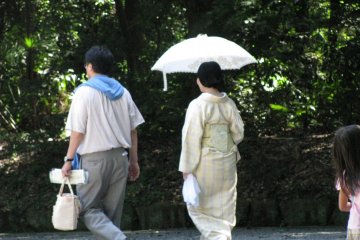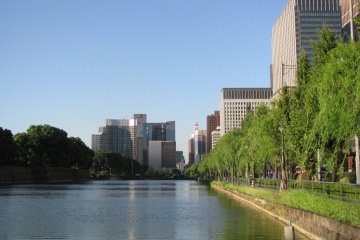From my very first visit to Japan I’ve learned how changeable the weather is. Since I know it's impossible to encounter perfect weather all the time, I now travel well prepared!
During a trip, the forecast each day can be different, but even during a single day the weather often changes. In cities the heat feels hotter and rainy weather is not propitious for sightseeing. On such days I try to stay indoors and visit museums or shops. In cities, even if you’ve forgotten your umbrella you can buy plastic umbrellas in any small shop, and they even display umbrellas right by the entrance. However if the weather is stormy with strong winds, umbrellas are useless and it’s better to have a raincoat — the wind will just turn an umbrella inside out! If such stormy weather starts, it’s better to ‘hide’ somewhere as train stations get crowded. During a typhoon it’s better to stay in one place such as a hotel or a museum where you can spend a few hours until the peak of the typhoon is over.
During sunny weather days, light-proof umbrellas and sunglasses are very useful and Japanese ladies always hide from the active sun. So, I always have an umbrella and light raincoat with me.
The weather is particularly changeable along the coast or in mountainous regions. I experienced these rapid changes first-hand on my visit to Matsushima. The day started out very warm with blue skies and sunshine, then by noon clouds started to gather and soon after that it rained heavily. After the rain, the sun appeared again but not for too long — blue-black clouds ended up covering all visible sky to the horizon, so I decided to return to Sendai. When I stayed in Ito located on the coast of Sagami Bay, each of the three days was different. The first day was gloomy and dark, the second day was sunny and bright, and the third day was stormy with big waves.
In mountainous regions the weather changes quite often, too. Good luck is needed if you want to see Fuji-san, as there is the possibility that you can’t see the mountain when it's hidden in thick clouds. My first attempt to see Fuji-san was a flop. The second time was successful because my Japanese friend said we had to be patient and wait. When we arrived in Owakudani, the top of Fuji-san was in the clouds, but in two hours it cleared to the joy of all the people who also waited. However, the snowy top of Fuji-san was visible for just an hour and then clouds covered it again.
If you're prepared, the capricious and changeable weather will not be an obstacle to your travel!



































